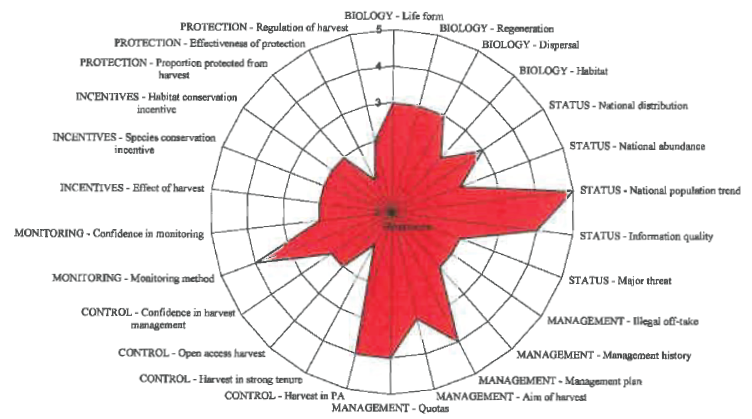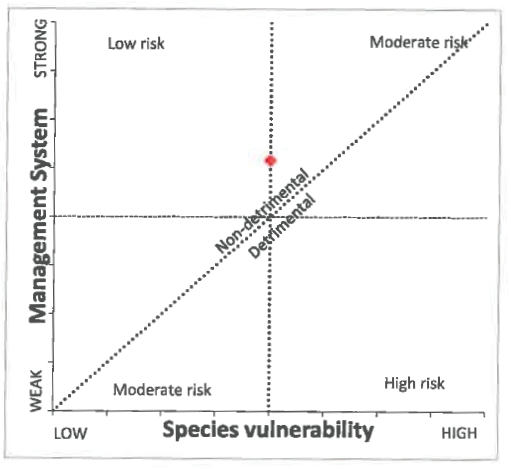


National Environmental Management: Biodiversity Act, 2004 (Act No. 10 of 2004)NoticesNon-Detriment find Assessment for Aloe ferox (Bitter Aloe)Summary of findings |

Aloe ferox (bitter aloe) is included in Appendix ll of the Convention on International Trade Endangered Species of Wild Fauna and Flora (CITES). In terms of Article IV of the Convention, an export permit shall only be granted for an Appendix II species when a Scientific Authority of the State of export has advised that such an export will not be detrimental to the survival of that species the wild. This document details the undertaking of a Non-Detriment Finding (NDF) assessment (Figure 1) for A. ferox and is based on the best available information, current as of September 2018.
Aloe ferox is a long-lived, single-stemmed succulent plant that can grow to heights of up to 6 m. The species is adapted to withstand a wide range of climatic conditions and can be found growing on rocky hill slopes in flat open areas and across a range of habitat types including fynbos, grassland, Karoo vegetation and valley bushveld. Flowering usually occurs between May and August when mature plants produce a single, branched inflorescence with 5-12 erect, dense racemes with orange-red flowers and large quantities of seed. The species is considered to be relatively easily propagated by seed although sufficient empirical data regarding the regeneration potential of the species has not yet been generated. Aloe ferox has a weed like ecology and is believed to be a pioneer plant due to its ability to thrive in degraded areas. The relatively large distribution range of A. ferox generally implies that the species has good dispersal efficiency (wind-dispersed). Young populations form clumps that act as nuclei from which new plants spread slowly over time, mature individuals forming the centre of the densest stands.
Aloe ferox occurs primarily in the Eastern Cape Province, extending down to the Western Cape Province and up into the south -eastern Free State. The species also occurs in southern Lesotho. Records of A. ferox from KwaZulu-Natal (KZN) Province have been confirmed as the similar looking Aloe candelabrum, which is still considered to be a synonym of A. ferox by CITES. Up-to-date population size estimates for A. ferox are lacking; although the species is considered to be common throughout its national distribution range which is estimated to be around 168 000 km2. The national population trend is currently unknown, however anecdotal information suggests that there has been an overall increase in the population size with limited local extirpations being reported in communal areas in the Eastern Cape. In the Western Cape, high numbers of recruits and improved growth rates have reportedly been observed in harvested populations, though limited research suggests that harvesting may lower reproductive output.
The major threats to A. ferox include habitat loss resulting from land use changes and over-utilization; however, these threats are considered to be limited and reversible, respectively. Research suggests that a higher density of A. ferox in some parts of the Eastern Cape is attributable to the historical decline of large herbivores such as elephants, rhinoceroses and kudu in the landscape. The return of these herbivores may be creating demographic bottleneck for A. ferox, and observations are already showing that the 0.25 - 1 m height class is absent from grazed populations. There is also evidence of a demographic bottleneck in populations on livestock farms, where the 0.25 - 0.5 m height class is disappearing, and it is suspected that this is due to cattle trampling. These observations however require further investigation. Climate change has been identified as a potential threat to the species as cases of severe frost, drought, increased intensities and frequencies of fires, and very high temperatures are often associated with plant mortality, as well as lower seed production and recruitment in affected areas.
Aloe ferox is an economically important plant in South Africa, generating financial benefits for local communities and businesses involved in the collection, processing and sale of natural aloe resources for commercial use in the pharmaceutical and cosmetic industries. Whilst the trade in live plants is negligible, large quantities of A. ferox extracts are exported annually to Argentina, Germany, Italy, the United Kingdom and Japan. The majority of the material used in marketable A. ferox products is obtained from wild sources; hence the species remains one of South Africa's leading wild-harvested commercially traded plants. It is nevertheless challenging to ascertain the amount of plants being impacted by the trade and further comprehensive analyses of field harvests and trade records are needed.
The industry is slowly adapting to regulations on Bioprospecting Access and Benefit Sharing (BABS), which provides for the fair and legal acquisition and sustainable trade of resources governed by an adaptive management framework through permitting systems. The principal method of monitoring harvest presently is through reported exports and imports of A. ferox captured within the CITES Trade Database. The national monitoring of exports of the species (from South Africa) is effectively managed by South Africa's Scientific Authority, although the quality of the data is not as reliable as it should be, owing to errors in reporting. There is currently no field monitoring programme for the species and the direct effects of harvest on wild populations need to be elucidated. The local use of, and trade in, A. ferox plants and products within South Africa also remains under-evaluated.
It is difficult to ascertain the scale of illegal harvest but earlier research suggests a high likelihood of an illegal trade in A. ferox extracts, almost equivalent in scale to that of the legal trade. Whilst this may be an overestimate and is in need of updating, it is possible that an illegal trade is ongoing due to a lack of proactive management in the aloe industry. Furthermore, differing land tenure systems between the Eastern Cape and Western Cape present contrasting findings regarding illegal off-take of the species. Aloe ferox harvesting in the Western Cape is better managed as plants mostly occur on private lands where landowners have control over their properties. There is also evidence that traditional harvesting practices which promote sustainable use and that have been passed down over generations are applied across the province. In communal lands of the Eastern Cape however, there have been some reports of illegal harvesting or poorly monitored unsustainable harvesting. This is in part due to the difficulty in implementing harvest control strategies as natural resources are viewed as public goods within and around these shared areas. Illegal harvesting events are nonetheless currently considered to be insignificant at this time.
Less than 10% of the species population falls within strictly protected areas, however, owing to the abundance of A. ferox plants occurring outside of protected areas, there is no harvesting pressure or demand to harvest the resource from protected areas. The majority of harvesting (70%) occurs on private land while 30% occurs on communal or state-owned land. Responsible industry stakeholders ensure that their tappers are trained and practice sustainable harvesting methods across these areas where possible. Many tappers have self-imposed restrictions on their harvests in that they will only harvest a certain number and size of leaves (from mature plants) to ensure maximum product yield as well as sustained plant regeneration potential. It is also a common practise to ensure that harvesting cycles within an area are no shorter than 12 months to allow harvested plants to recover and produce good quality, harvestable leaves once more. It has been that the primary established purpose for harvesting A. ferox is to maximise economic yield whilst allowing for appropriate regrowth. Aloe ferox cultivation occurs mainly in the Western Cape, however, it accounts for a very limited portion of the production. This shows how important it is to ensure that wild populations are well managed.
There is currently no management plan for A. ferox, but the Eastern Cape Department of Economic Development, Environmental Affairs and Tourism, in collaboration with the national Department of Environment, Forestry and Fisheries (DEFF), has recently initiated a process to develop a Biodiversity Management Plan (BMP) for the species, which should further contribute to sustainable harvesting practices and monitoring of the resource base. In many areas, particularly in the Western Cape, there is informal management in place which has been informed by ancient indigenous harvesting practices. These are based on knowledge that has been passed down over generations without having changed substantially. Communal harvesting remains problematic in the Eastern Cape and as a result, there is an urgent need for effective management plans in this area.
This NDF indicates that the harvest and international trade in A. ferox is non-detrimental and poses a low to moderate risk to the population in the wild (Figure 1 and 2). The lack of robust data on the population size and trend of this species is a concern considering that the major threats that have been identified are over-utilization and habitat loss. A scientifically robust resource assessment has therefore been initiated to assess the size of the resource base and to inform a programme for the monitoring of A. ferox subpopulations at key sites. This monitoring programme will form part of the BMP that is currently under development. The BMP will also seek to standardize as far as possible management and control measures for the species across both the Eastern and Western Cape Provinces. The management of A. ferox in the Eastern Cape in particular, could be improved. Though this NDF recognizes the lack of key data, such as population size and trend, it is also intended to demonstrate that South Africa is determined to incrementally improve the management of this economically important wild resource.

Figure 1: Radar chart summarizing the non-detriment finding assessment for A. ferox in accordance with the CITES NDF checklist. Explanations of scores given are detailed in Table 1. Higher scores are indicative of higher risks to the species. The area shaded in the radar chart indicates an overall low to moderate risk to the species.

Figure 2: The risk of trading in A. ferox, as represented by the relationship between species vulnerability (biology and status) and the management system to which the species is subjected (management, control, monitoring, incentives and protection). The figure shows that the species is currently at a low to moderate risk and trade is non detrimental